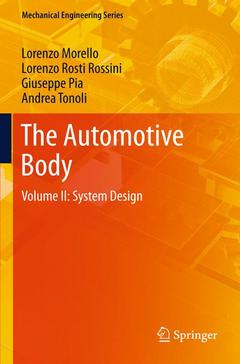The Automotive Body, 2011 Volume II: System Design Mechanical Engineering Series
Auteurs : Morello L., Rosti Rossini Lorenzo, Pia Giuseppe, Tonoli Andrea

?The Automotive Body? consists of two volumes.
The first volume produced the needful cultural background on the body; it described the body and its components in use on most kinds of cars and industrial vehicles: the quantity of drawings that are presented allows the reader to familiarize with the design features and to understand functions, design motivations and fabrication feasibility, in view of the existing production processes.
The purpose of this second volume is to explain the links which exist between satisfying the needs of the customer (either driver or passenger) and the specifications for vehicle design, and between the specifications for vehicle system and components. For this study a complete vehicle system must be considered, including, according to the nature of functions that will be discussed, more component classes than considered in Volume I, and, sometimes, also part of the chassis and the powertrain.
These two books about the vehicle body may be added to those about the chassis and are part of a series sponsored by ATA (the Italian automotive engineers association) on the subject of automotive engineering; they follow the first book, published in 2005 in Italian only, about automotive transmission.
They cover automotive engineering from every aspect and are the result of a five-year collaboration between the Polytechnical University of Turin and the University of Naples on automotive engineering.
7 INTRODUCTION TO VOLUME II.- 8 FUNCTIONS AND SPECIFICATIONS.- 8.1 Transportation statistics.- 8.2 Vehicle functions.- 8.3 Requirements measurement.- 8.4 Regulations.- 9 ERGONOMICS AND PACKAGING.- 9.1 Hints on Physiology.- 9.2 Manikins for interior packaging.- 9.3 Hints of occupants positioning.- 9.4 Pedals functionality and positioning.- 9.5 Interior packaging.- 9.6 Seat characteristics.- 9.7 Accessibility.- 9.8 Commands reach.- 9.9 Loading and unloading.- 9.10 Visibility.- 10 CLIMATIC COMFORT.- 10.1 Physiology outline.- 10.2 Passenger compartment energy balance.- 10.3 HEVAC System design and testing.- 11 NOISE, VIBRATION, HARSHNESS.- 11.1 Sensitivity to noise.- 11.2 Sources of noise and vibration.- 11.3 Dynamic behavior of the car body and modal analysis.- 11.4 Engine suspension.- 11.5 Acoustic transmission and insulation.- 12 STRUCTURAL INTEGRITY.- 12.1 Internal and external loads.- 12.2 Behavior of thin wall structures.- 12.3 Simplified structural models.- 12.4 Numerical modelsfor structural analysis.- 12.5 Measurement of the car body stiffness.- 13 PASSIVE SAFETY.- 13.1 Biomechanics.- 13.2 Simplified models for crash.- 13.3 INTRODUCTION ON IMPACT ENERGY ABSORBERS.- 13.4 FRONT STRUCTURE CONFIGURATION.- 13.5 TESTING ON VEHICLES.- 13.6 IMPACT TESTS EQUIPMENT.- 13.7 NON LINEAR FEM ANALYSIS.- 13.8 Simplified models for crash.- 13.9 INTRODUCTION ON IMPACT ENERGY ABSORBERS.- 13.10FRONT STRUCTURE CONFIGURATION.- 13.11TESTING ON VEHICLES.- 13.12IMPACT TESTS EQUIPMENT.- 13.13NON LINEAR FEM ANALYSIS.- References.- INDEX.
Lorenzo Morello received his degree in Mechanical Automotive Engineering in 1968 at the Politecnico of Turin. He immediately began his career at the Politecnico as Assistant of Machine Design and Technologies.
Leaving the Politecnico in 1971, went to work at a branch of Fiat dedicated to vehicle studies, one that has been joined to the new Research Centre in 1976. He participates in the development of cars and experimental prototypes for the ESV US Program. He has also developed mathematical models for vehicle suspensions and road holding simulations.
Since 1973 he has been involved in a major project for the development of mathematical modeIs of the vehicle, to address the product policies of the company in facing the first energy crisis; as part of this activity he began the development of a new automatic transmission for reduced fuel consumption and a small direct injection diesel engine to be used on automobiles.
Dr. Morello was appointed manager of the chassisdepartment of the Vehicle Research Unit and has coordinated the development of many research prototypes, such as electric cars, off-road vehicles, trucks and buses. He was appointed manager of the same Research Unit in 1977 and has been leading a group of about 100 design engineers, dedicated to the development of prototypes. A new urban bus with unitized thin steel sheet body, with spot welded joints, a commercial vehicle that will start production later, a small lightweight urban car, under contract from the National Research Council, and a hybrid car, under contract from the US Department of Energy, were developed in this period of time.
He took responsibility of the Engine Research Unit in 1980; this group, of about 200 people, was primarily dedicated to the development of new car engines. He has managed the development of many petrol engines according to the principle of high turbulence fast combustion. A direct injection diesel engine for cars, many turbocharged pre-chambe
Date de parution : 10-2014
Ouvrage de 567 p.
15.5x23.5 cm
Date de parution : 12-2010
Ouvrage de 567 p.
15.5x23.5 cm
Thèmes de The Automotive Body :
Mots-clés :
automotive body; automotive engineering; body design; Engineering; Aerospace Technology



